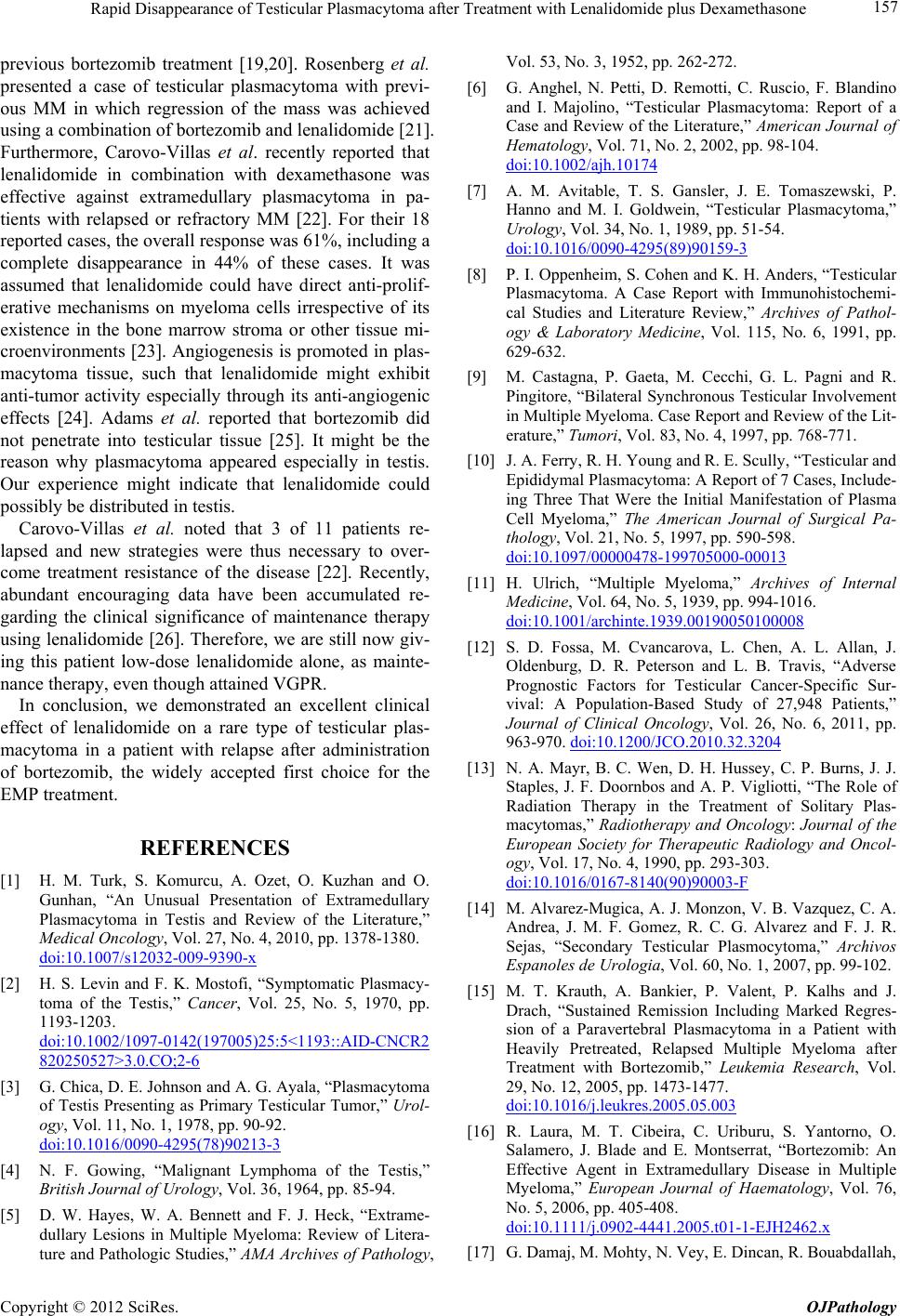
Rapid Disappearance of Testicular Plasmacytoma after Treatment with Lenalidomide plus Dexamethasone 157
previous bortezomib treatment [19,20]. Rosenberg et al.
presented a case of testicular plasmacytoma with previ-
ous MM in which regression of the mass was achieved
using a combination of bortezomib and lenalidomide [21].
Furthermore, Carovo-Villas et al. recently reported that
lenalidomide in combination with dexamethasone was
effective against extramedullary plasmacytoma in pa-
tients with relapsed or refractory MM [22]. For their 18
reported cases, the overall response was 61%, including a
complete disappearance in 44% of these cases. It was
assumed that lenalidomide could have direct anti-prolif-
erative mechanisms on myeloma cells irrespective of its
existence in the bone marrow stroma or other tissue mi-
croenvironments [23]. Angiogenesis is promoted in plas-
macytoma tissue, such that lenalidomide might exhibit
anti-tumor activity especially through its anti-angiogenic
effects [24]. Adams et al. reported that bortezomib did
not penetrate into testicular tissue [25]. It might be the
reason why plasmacytoma appeared especially in testis.
Our experience might indicate that lenalidomide could
possibly be distributed in testis.
Carovo-Villas et al. noted that 3 of 11 patients re-
lapsed and new strategies were thus necessary to over-
come treatment resistance of the disease [22]. Recently,
abundant encouraging data have been accumulated re-
garding the clinical significance of maintenance therapy
using lenalidomid e [26]. Therefore, we are still now giv-
ing this patient low-dose lenalidomide alone, as mainte-
nance therapy, even though attained VGPR.
In conclusion, we demonstrated an excellent clinical
effect of lenalidomide on a rare type of testicular plas-
macytoma in a patient with relapse after administration
of bortezomib, the widely accepted first choice for the
EMP treatment.
REFERENCES
[1] H. M. Turk, S. Komurcu, A. Ozet, O. Kuzhan and O.
Gunhan, “An Unusual Presentation of Extramedullary
Plasmacytoma in Testis and Review of the Literature,”
Medical Oncology, Vol. 27, No. 4, 2010, pp. 1378-1380.
doi:10.1007/s12032-009-9390-x
[2] H. S. Levin and F. K. Mostofi, “Symptomatic Plasmacy-
toma of the Testis,” Cancer, Vol. 25, No. 5, 1970, pp.
1193-1203.
doi:10.1002/1097-0142(197005)25:5<1193::AID-CNCR2
820250527>3.0.CO;2-6
[3] G. Chica, D. E. Johnson and A. G. Ayala, “Plasmacytoma
of Testis Presenting as Primary Testicular Tumor,” Urol-
ogy, Vol. 11, No. 1, 1978, pp. 90-92.
doi:10.1016/0090-4295(78)90213-3
[4] N. F. Gowing, “Malignant Lymphoma of the Testis,”
British Journal of Urology, Vol. 36, 1964, pp. 85-94.
[5] D. W. Hayes, W. A. Bennett and F. J. Heck, “Extrame-
dullary Lesions in Multiple Myeloma: Review of Litera-
ture and Pathologic Studies,” AMA Archives of Pathology,
Vol. 53, No. 3, 1952, pp. 262-272.
[6] G. Anghel, N. Petti, D. Remotti, C. Ruscio, F. Blandino
and I. Majolino, “Testicular Plasmacytoma: Report of a
Case and Review of the Literature,” American Journal of
Hematology, Vol. 71, No. 2, 2002, pp. 98-104.
doi:10.1002/ajh.10174
[7] A. M. Avitable, T. S. Gansler, J. E. Tomaszewski, P.
Hanno and M. I. Goldwein, “Testicular Plasmacytoma,”
Urology, Vol. 34, No. 1, 1989, pp. 51-54.
doi:10.1016/0090-4295(89)90159-3
[8] P. I. Oppenheim, S. Cohen and K. H. Anders, “Testicular
Plasmacytoma. A Case Report with Immunohistochemi-
cal Studies and Literature Review,” Archives of Pathol-
ogy & Laboratory Medicine, Vol. 115, No. 6, 1991, pp.
629-632.
[9] M. Castagna, P. Gaeta, M. Cecchi, G. L. Pagni and R.
Pingitore, “Bilateral Synchronous Testicular Involvement
in Multiple Myeloma. Case Report and Review of the Lit-
erature,” Tumori, Vol. 83, No. 4, 1997, pp. 768-771.
[10] J. A. Ferry, R. H. Young and R. E. Scully, “Testicular and
Epididymal Plasmacytoma: A Report of 7 Cases, Include-
ing Three That Were the Initial Manifestation of Plasma
Cell Myeloma,” The American Journal of Surgical Pa-
thology, Vol. 21, No. 5, 1997, pp. 590-598.
doi:10.1097/00000478-199705000-00013
[11] H. Ulrich, “Multiple Myeloma,” Archives of Internal
Medicine, Vol. 64, No. 5, 1939, pp. 994-1016.
doi:10.1001/archinte.1939.00190050100008
[12] S. D. Fossa, M. Cvancarova, L. Chen, A. L. Allan, J.
Oldenburg, D. R. Peterson and L. B. Travis, “Adverse
Prognostic Factors for Testicular Cancer-Specific Sur-
vival: A Population-Based Study of 27,948 Patients,”
Journal of Clinical Oncology, Vol. 26, No. 6, 2011, pp.
963-970. doi:10.1200/JCO.2010.32.3204
[13] N. A. Mayr, B. C. Wen, D. H. Hussey, C. P. Burns, J. J.
Staples, J. F. Doornbos and A. P. Vigliotti, “The Role of
Radiation Therapy in the Treatment of Solitary Plas-
macytoma s,” Radiotherapy and Oncology: Journal of the
European Society for Therapeutic Radiology and Oncol-
ogy, Vol. 17, No. 4, 1990, pp. 293-303.
doi:10.1016/0167-8140(90)90003-F
[14] M. Alvarez-Mugica, A. J. Monzon, V. B. Vazquez, C. A.
Andrea, J. M. F. Gomez, R. C. G. Alvarez and F. J. R.
Sejas, “Secondary Testicular Plasmocytoma,” Archivos
Espanoles de Urologia, Vol. 60, No. 1, 2007, pp. 99-102.
[15] M. T. Krauth, A. Bankier, P. Valent, P. Kalhs and J.
Drach, “Sustained Remission Including Marked Regres-
sion of a Paravertebral Plasmacytoma in a Patient with
Heavily Pretreated, Relapsed Multiple Myeloma after
Treatment with Bortezomib,” Leukemia Research, Vol.
29, No. 12, 2005, pp. 1473-1477.
doi:10.1016/j.leukres.2005.05.003
[16] R. Laura, M. T. Cibeira, C. Uriburu, S. Yantorno, O.
Salamero, J. Blade and E. Montserrat, “Bortezomib: An
Effective Agent in Extramedullary Disease in Multiple
Myeloma,” European Journal of Haematology, Vol. 76,
No. 5, 2006, pp. 405-408.
doi:10.1111/j.0902-4441.2005.t01-1-EJH2462.x
[17] G. Damaj, M. Mohty, N. Vey , E. Dincan, R. Bouabdallah,
Copyright © 2012 SciRes. OJPathology